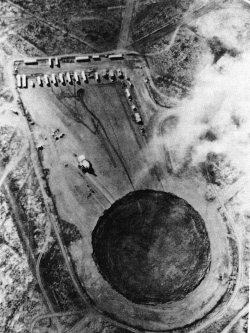How do you ensure that fancy new military satellite is tough enough to withstand an orbital EMP attack by the Soviets? By shooting it with your own nuclear bomb using this massive, movable test chamber, obviously.
During the Cold War, players on both sides of the Iron Curtain worked just as hard devising ways to bring each other’s satellites down as they did to get their own orbiters up. One of the most radical methods proposed involved nuking space itself to create an artificial Van Allen Belt and EMP wave, frying the circuitry of all satellites that passed through it. And for nearly two decades between 1962 and 1980, American researchers at the Yucca Flats test range sought to shield our satellites from such blasts, culminating in the Project Tinderbox — a giant, 45-tonne vacuum chamber on tank treads — in June 1980.
This huge, $US10.3 million test chamber, mounted atop tractor treads and connected to a long length of winched steel cable, was large enough to hold an actual Defence Satellite Communication System satellite, the DSCS III, suspended inside a vacuum chamber designed to simulate the space environment. It sat atop a 300m deep vertical shaft drilled into the ground at the Nevada Test Site. At the other end of the shaft sat a low-yield — less than 20kt — nuclear device dubbed the Huron King shot.

The idea was to detonate the bomb underground (nuclear arms treaties had already outlawed above ground tests), forcing the radiation to flow up the shaft and irradiate the satellite within the chamber for a fraction of a second, then yank the 45-tonne test bed out of the way before the explosion caused the shaft to collapse in upon itself (sealing off the radiation leak) while subsiding as much as 60m below the rest of the valley floor.
Upon inspection, the DSCS III booted and operated without a hitch, indicating that the satellite’s new-fangled anti-radiation shielding had worked as intended. While the data that researchers collected from the test was quite valuable and helped spur on further radiation hardening developments to protect America’s most vital satellites, the test chamber itself was only employed once, for Project Tinderbox. For the last 34 years, it has sat where it came to originally came to rest, slowly rusting in the hot Nevada sun. You can see it for yourself during the test range’s occasional public tours. [Medium – Wiki]
